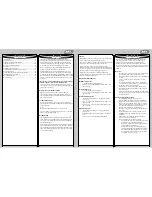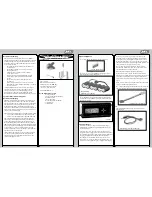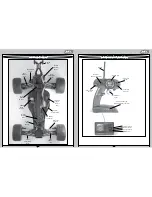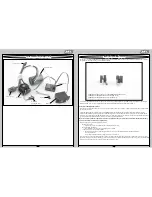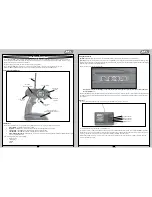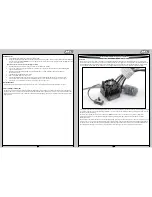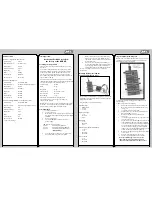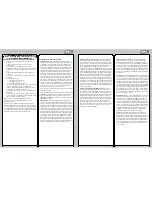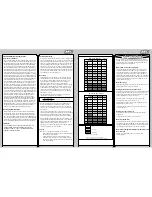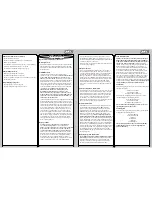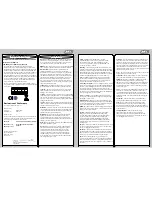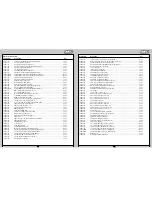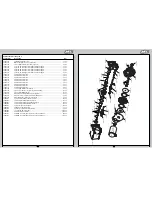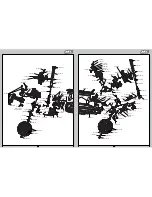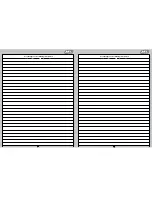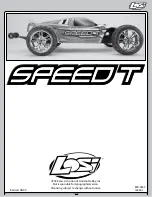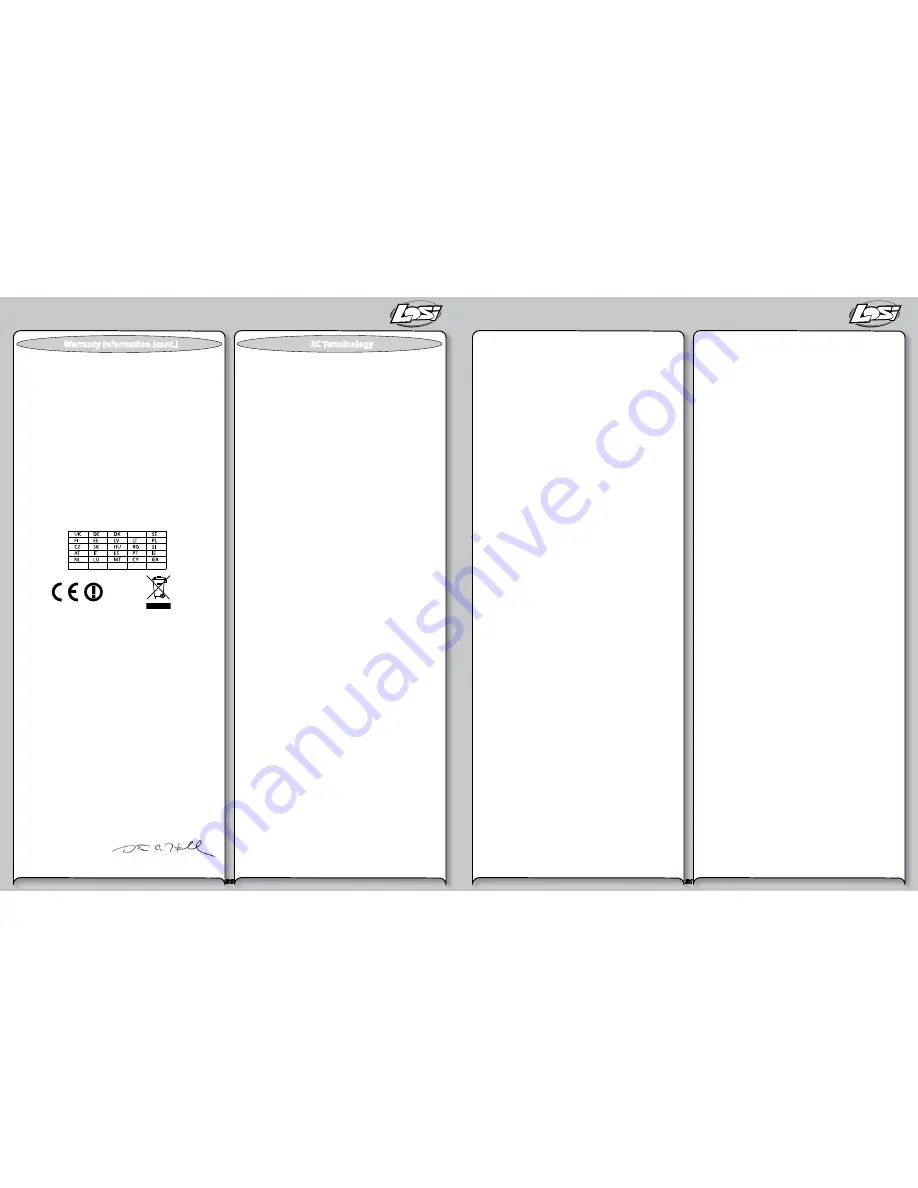
30
31
®
®
BEC
(Battery Elimination Circuit) – The BEC is used to eliminate
the need for a receiver pack to power the radio system. On
most electric vehicles this is located in the electronic speed
control (ESC), but can also be a stand-alone device.
BIND Process
– Programming a receiver to recognize the GUID
code of only one specific transmitter or transmitter module.
Brushless Motor
– A brushless motor differs from the
traditional brushed motor in several ways. As the name
indicates there are no brushes used to transfer current to the
windings. The brushless motor windings are located in the
can, where in a brushed motor they are on the armature. The
armature in a brushless motor is replaced by a rotor, which
is magnetic and spins within the windings on the can. An
ESC is required to run and control a brushless motor where a
traditional brushed motor can be run by connecting power to
the positive and negative tabs.
Calibration
– Also called ESC setup. It is the process used to
match the transmitter throttle, brake and neutral to the ESC.
Capacitor
– An electronic component used to store voltage.
The Xcelorin ESC uses a capacitor to store energy from the
braking action of the ESC.
Cogging
– This term describes a brushless motor when starting
from a complete stop. The ESC and motor work together during
the start from a complete stop, and it is during this startup
process you may notice some stuttering of the vehicle until it is
rolling in either direction.
Current
– Refers to the power flow from the battery to the ESC
and Motor when used in the RC vehicle environment. Typically
this is measured in Ampere or Amp.
Deadband
– This refers to the amount of travel (movement) on
the transmitter trigger before the vehicle is requesting the ESC
to move the vehicle forward or backwards. It is an advanced
adjustment used by experienced drivers.
Drag Brake
– Refers to the amount of brake applied when
driving the vehicle that is applied when you return the
transmitter trigger to the neutral position. This advanced
adjustment is used by experienced drivers and is adjusted on
the ESC to the feel of the driver.
DSM
– (Digital Spectrum Modulation) – The 2.4GHz technology
that makes Spektrum possible.
ESC
(Electronic Speed Control) – The ESC is what translates
the signals past from the transmitter trigger through the
receiver into commands that reach the motor to signal
forward or reverse, acceleration or braking. The Xcelorin
system is an advanced electronic speed controller that is
very efficient in passing precise requests to the brushless
motor. The BEC is also controlled by the ESC along with the
Low Voltage Protection circuit.
GUID
– Globally Unique Identification Code. Each
individual module or radio is factory programmed with
its own unique serial code. In the binding process, the
receiver is programmed to only recognize the GUID code
of one specific radio or module.
Kv Rating
– This is the rating used for most brushless motors
rather than turns, which is the rating for brushed motors. A Kv
number for a motor is stating the Revolutions Per Minute (RPM)
that will be developed if one volt is supplied without a load.
The motor supplied with the Speed-T is a 4800Kv motor, which
would develop 4800 RPM at the one volt measurement.
LiPo
– A Lithium Polymer battery’s abbreviation indicating
the chemistry used in these rechargeable batteries. These
batteries require special attention by the user and are only
recommended for the most experienced of users.
Low Voltage Cutoff (LVC)
– This is a setting for the ESC, to help
protect the investment into expensive LiPo batteries. When the
ESC turns on a Red LED light on the Xcelorin ESC this indicates
LVC has been reached, and at the same time power to the
motor will be reduced as another indication for the driver that
the battery is close to full discharge. For NiCd or NiMH batteries
only this setting can be set to “no cutoff.”
mAh
– The Milliampere Hour abbreviation, which represents
the capacity of a battery pack. The higher this rating the longer
the run time of each charge.
Neutral Position
– Referring to the Transmitter when at rest,
meaning the throttle trigger and steering have no input. When
you turn the transmitter on set it to the side while turning the
car on, the transmitter will be in a Neutral state.
NiMH
– The abbreviation for nickel-metal hydride rechargeable
batteries. These have replaced the use of NiCd batteries as the
battery of choice in RC vehicles.
Profiles
– The Xcelorin ESC has three (3) preset profiles.
Each profile contains the individual ESC settings that
are collectively called a profile. There is a beginner profile,
an expert profile, and a beginner LiPo profile that can
easily be retrieved and used simplifying ESC use for the
user. These profiles do not limit the ability to make further
settings changes to the ESC but are a good reference and
starting point.
Receiver
– A device mounted into the vehicle that receives and
decodes a signal sent by a transmitter. Servos, ESC and other
devices are plugged into the receiver.
Resistance
– As used here is referring to the power loss from
the battery to the ESC and Motor. Typically this is measured in
Ampere or Amp. Too much resistance between the battery, ESC
and motor can result in low performance and run time.
Rotor
– This is the brushless motors equivalent to an
armature in a brushed motor. The rotor is the shaft protruding
from the end of the motor for mounting of the pinion gear to
drive the vehicle. The rotor has a magnet secured to it inside of
the motor.
Sensorless
– Is a type of brushless system, of which there are
two primary types: Sensorless and Sensored. The Sensorless
system uses the ESC to determine the rotation of the rotor in
the motor, no feedback is provided by the motor itself. In the
Sensored system, the ESC and Motor are connected via a sensor
cable in addition to the three wires found on a Sensorless
system. This cable allows the motor to communicate directly to
the ESC providing further controls.
Servo
– An electronic device connected to the receiver used to
actuate steering control of the vehicle.
Solder Tabs
– The Xcelorin 4800Kv motor in the Speed-T has
three solder tabs to attach the motor leads from the ESC.
Spektrum
– The technology brand of 2.4GHz radio system
supplied with the Speed-T. The use of this technology
eliminates the concern of conflicting frequencies found with
older legacy radio systems. It further reduces to a minimum
potential radio interference common with the legacy radio
systems of the past.
Spool
– Is a variation of the differential and provides positive
drive under acceleration. The components are the same as
a normal differential without using the steel balls, which are
replaced by Spool Pads. The spool can be easily converted into
a differential by removal of the Spool Pads and inserting the
steels balls.
Transmitter
– Is the device held in your hand that relays
steering and throttle/brake requests made to the receiver.
Trim
– This is a setting used on the transmitter to make
fine adjustments to the steering or throttle/brake trigger.
For steering you would use the trim to make the adjustment
for the vehicle to drive straight without adding steering input
to the transmitter.
Thermal Shutdown
– Refers to the ESC operating
temperature. The Xcelorin ESC monitors its internal
temperature and will automatically prevent the ESC from
delivering power to the motor, preventing damage due to
over heating the ESC’s electronics.
Compliance Information for the European Union
Instructions for Disposal
of WEEE by Users in the European Union
This product must not be disposed of with other waste.
Instead, it is the user’s responsibility to dispose of their waste
equipment by handing it over to a designated collection point
for the recycling of waste electrical and electronic equipment.
The separate collection and recycling of your waste equipment
at the time of disposal will help to conserve natural resources
and ensure that it is recycled in a manner that protects human
health and the environment. For more information about where
you can drop off your waste equipment for recycling, please
contact your local city office, your household waste disposal
service or where you purchased the product.
The associated regulatory agencies of the following countries
recognize the noted certifications for this product as authorized
for sale and use:
Declaration of Conformity
(in accordance with ISO/IEC 17050-1)
No. HH20090807
Product(s):
SPEED-T RTR
Item Number(s):
LOSB0101
Equipment class:
2
The objects of declaration described above are in conformity with the
requirements of the specifications listed below, following the provi-
sions of the European R&TTE directive 1999/5/EC:
EN 300-328
Technical requirements for Radio equipment
EN 301 489-1 v.1.6.1
General EMC requirements for Radio
equipment
EN 301 489-17 v.1.2.1
Signed for and on behalf of:
Horizon Hobby, Inc.
Champaign, IL USA
Aug 07, 2009
Steven A. Hall
Vice President
International Operations and Risk Management
Horizon Hobby, Inc.
BG
Warranty Information (cont.)
RC Terminology

